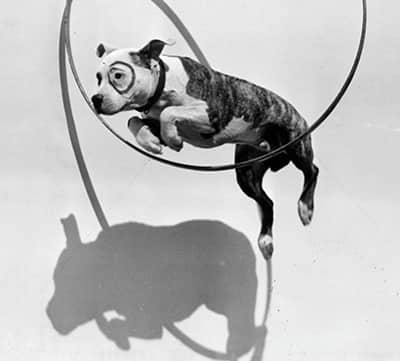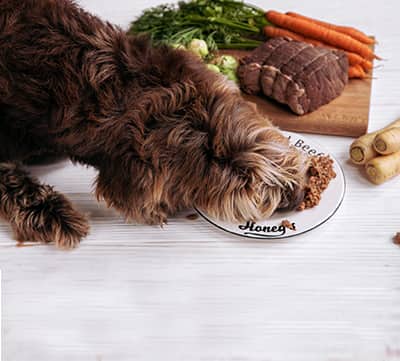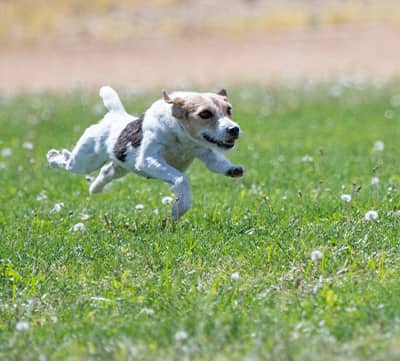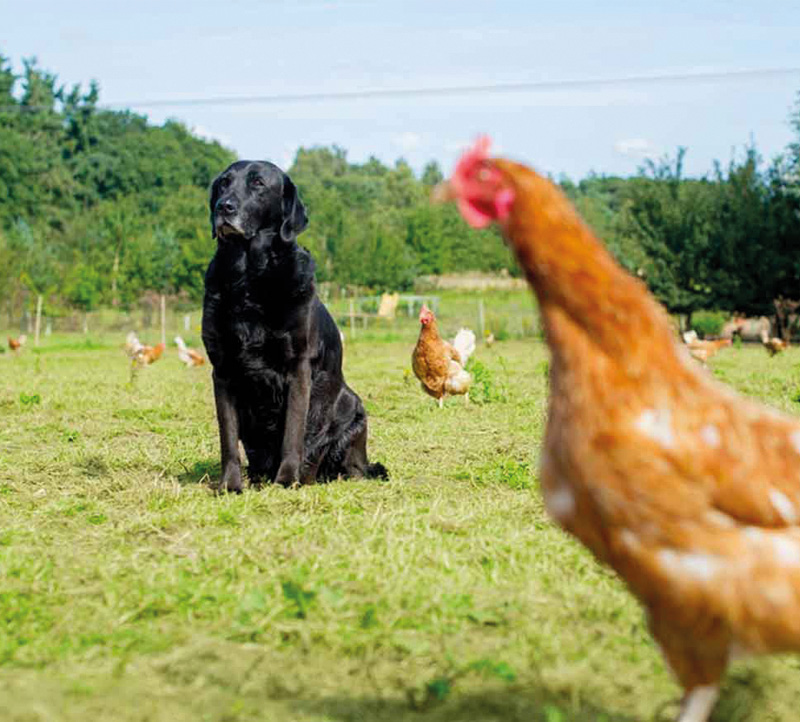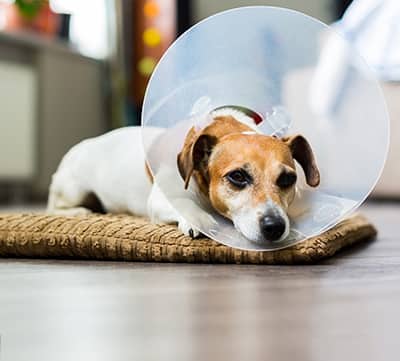Why dogs are wrestling with their weight for the first time in four million years
British dogs are getting heavier. The most recent research into this was conducted by the Pet Food Manufacturers Association (PFMA), which found that 45 out of every 100 dogs were either overweight or obese, a substantial increase on the previous survey. The organisation called upon pet owners to ‘resist overfeeding and excessive treating’.
There is an irony to the PFMA’s interest in this area as many of their members, being dog food manufacturers, could be considered part of the problem, not part of the solution. Modern dog food, with its lack of protein, high level of carbohydrates and unhealthy fats, is the single most important reason why our canine companions are becoming chubbier.
Moreover, manufacturers, never being slow to see a business opportunity, have now developed special ‘weight loss’ dog foods to correct a situation largely of their own making. These diet foods tend to be packed with crude fibre (such as beet pulp or peanut shells), which has the effect of filling a dog up without offering it any nutrition whatsoever.
Nature knows best
Before I say another word, what dog food manufacturers are trying to do, in their warped way, is replicate a natural diet using inexpensive and often inappropriate ingredients. Modern dog food is highly processed and, almost without exception, utilises poor quality ingredients, which through methods such as cooking and extrusion, have lost most of whatever nutritional value they may ever have contained. What we are talking about is junk food for dogs. The best way for any species (including humans) to get their nutrition is in its most natural form.
What dogs eat when given the choice
The best way to understand the shortcomings of modern, processed dog food is to compare it with a dog’s biologically appropriate diet (the food it must have to optimise its health). Happily, we have two ways of knowing what this is. Firstly, there has been a lot of research into what wild dogs (such as the dingoes in Australia) eat when they have complete freedom of choice. Secondly, domesticated dogs and wolves have the identical digestive systems from their teeth to – ahem – their tails. As they are the same species, this isn’t so surprising, and it provides scientific proof as to why they should be eating the same diet.
What do wild dogs and wolves eat? Small and medium sized prey animals such as mice, voles, rabbits, birds and – where available – fish. They consume every bit of the animal, too, including the bones (which supply about a third of their nutritional requirements) and the stomach contents. They also scavenge, eating a wide variety of grasses, herbs, vegetables and fruits as well as less appetising things such as faeces.
An analysis of a dog’s natural diet
A very clever canine nutrition expert called Steve Brown has analysed what wild dogs and wolves eat in order to ascertain what domesticated dogs require. After extracting the water (in other words on a ‘dry matter’ basis) he found that the dog’s natural diet consists of:
- 49% protein
- 44% fat
- 6% carbohydrate
By the way, although 44% of the calories come from fat, in terms of volume of food it only accounts for around 6% of the diet. This is because fat is calorie rich.
Modern, processed dog food doesn’t stack up that well.
How does modern, processed dog food stack up when compared to a dog’s natural diet? As the law allows manufacturers to present the ingredients they use in a very misleading way that is difficult to answer. For example, they can hide the percentage of carbohydrates and disguise the volume and type of fat. However, my own research suggests the following averages:
| Protein | Fat | Carbohydrate | |
| Natural or wild diet | 49% | 44% | 6% |
| Dry food i.e. kibble | 27% | 30% | 43% |
| Canned food | 32% | 58% | 10% |
You’ll notice that modern dog food is low in protein and high in carbohydrate. This is the opposite of a dog’s natural diet and also contrary to all the scientific research regarding weight loss (which I will come on to in a moment). The fat content is low or high depending on whether you feed kibble or canned food, but either way it is harmful as manufacturers use inappropriate and unhealthy fat.
The importance of protein
Why is the amount of protein in your dog’s diet so important? And does it matter what the source of that protein is?
Protein is what your dog needs to form healthy cells, organs, protective tissue, hormones, enzymes, tendons and ligaments. It is essential for a good immune system and the mainstay of a wolf or wild dog’s natural diet, accounting for around 90% of what it eats and providing around half the calories it requires. Research published in 2010 shows that a high-protein diet has the additional advantage of making a dog feel ‘fuller’.
There is protein and protein! In a natural diet it comes almost completely from animal sources (meat and fish) which, unlike the vast majority of plants, contain the right balance of amino acids as well as a complete range of protein-type nutrients (for example taurine and carnitine).
The protein in modern, processed dog food has various drawbacks. To begin with, the main constituent of protein, amino acids, are altered and can be destroyed by heat. It has, of course, been cooked. Even if the proteins survive the rendering process (when they are, essentially, boiled for a long period of time) they are of low quality, being from factory farmed animals. Also, some modern dog food relies on lesser, plant-based proteins.
The scientific evidence is clear: dogs need the protein supplied by a natural, raw diet.
The importance of fat
Fats break down into three different types: saturated fats, monounsatu rated fats and polyunsaturated fats. In their natural state in animals these come from muscle meat, storage fat, bone marrow and organ fat. By feeding your dog different types of meat you make sure that he or she receives the right quantity of ‘good’ fats in their most natural state.
Fat is a vital part of your dog’s diet. First and foremost, fat produces energy. The right sorts of fats are necessary for the absorption of fat-soluble vitamins. Additionally, they protect the nerve fibres in the body, provide protection from the cold and are the ideal source of essential fatty acids. They are anti-inflammatory, too. The most important fatty acids for a dog are omega-6 and omega-3.
The fats you serve your dog should be fresh. Rancid and poor quality fats can really harm dogs, robbing them of essential fatty acids. The fat used in modern, processed dog food is of the poorest quality imaginable and comes from a variety of sources including the waste fat left over from fast food businesses. It has almost no nutritional value and is the single most important reason why dogs put on weight. Where extra fats (such as fish oils, a vital source of Omegas) are added to factory produced dog food they generally turn rancid by the time the food is eaten. This is because as soon as fat comes into contact with air it starts to oxidise. The more rancid a fat, the less valuable it is as it will have the effect of reducing the nutritional value of the protein, vitamins and antioxidants so necessary to your dog’s health.
So, the rules with fat are (a) you must avoid the damaging fats in modern, processed dog food, (b) even though a dog may be trying to lose weight you shouldn’t cut out fat completely, only reduce the quantity.
The problem with carbohydrates
What is wrong with feeding a dog carbohydrates? Simple carbohydrates (such as rice, barley and oats) increase blood sugar, stimulate the production of pre-inflammatory hormones and (in plain English) play merry hell with a dog’s immune system.
There is another problem, which is that dogs lack the digestive system required to convert most carbohydrates into a form they can actually use. Modern, processed dog food is very high in carbohydrates and the worst thing is that they are high-fibre carbohydrates. The cellulose in the fibre can’t be digested (it goes in one end and out the other) and the starches reduce the body’s ability to absorb other vital nutrients such as calcium, magnesium, zinc and iron. A growing number of vets believe that it is the high levels of carbohydrates in modern dog food that are making so many dogs vulnerable to illness and disease.
It isn’t just the food
There is, of course, another reason why dogs are becoming overweight: lack of exercise. Society has, of course, become increasingly pressured and many people find themselves without the necessary time or energy to walk their dogs as much as they would wish. Most breeds need a minimum of an hour a day, but the PFMA says that only about a third of dogs are receiving this level. There is another problem, too. In the old days dogs were allowed to roam relatively freely. Even where this was against the local authority’s regulations, a blind eye would be turned to the practice of turning dogs out for part or all of the day. My memory may be faulty, but I had no sense growing up that there were more cases of dogs biting people than there are now. Rather, I remember a society that was much more dog friendly. A society in which dogs frequently exercised themselves. I am not suggesting we turn the clock back, but it is another reason why dogs are more likely to be overweight.
Why your dog’s weight is such a big issue
Does it really matter if your dog is carrying a little extra weight? If you care about your dog’s health then the answer is yes. Excess weight will reduce your dog’s life expectancy and will make him or her prone to all sorts of serious health problems including (but not only) joint disease, arthritis, heart disease, hypertension, respiratory problems, asthma, pancreatitis, diabetes, liver disease, skin issues, cancer and a compromised immune system.
What the experts say about protein
‘Research shows that a high-protein, low-carbohydrate diet is the safest and most effective weight loss program for dogs,’ say Jean Hofve DVM and Dr Celeste Yarnall, authors of Paleo Dog.
‘Protein,’ says Dr Lew Olson, author of Raw and Natural Nutrition for Dogs, ‘is a dog’s best friend.’ She goes on to point out that: ‘Recent studies have confirmed that a high level of protein is not just beneficial, but necessary for dogs of all ages.’
‘Protein,’ according to Steve Brown, author of Unlocking the Canine Ancestral Diet, ‘provided 49% of the calories in the dog’s ancestral diet, our gold standard.’
‘Protein,’ says Dr Karen Becker, author of Real Food for Healthy Dogs and Cats, ‘is the foundation of the diet of a carnivore, necessary for the formation of healthy cells, enzymes, hormones, ligaments, tendons, organs and protective tissue. Next to water, it makes up the majority of our pet’s body weight.’
‘To maximize our pets’ health,’ says Dr Ian Billinghurst, author of The BARF Diet: Raw Feeding for Dogs and Cats using Evolutionary Methods (and other titles), ‘we should supply our pets with protein that mimics the protein eaten by their wild ancestors.’
Check for underlying health issues
If you feel that your dog’s weight issues can’t be properly explained by diet or lack of exercise then I would urge you to talk to your vet about whether it could be caused by thyroid issues or some type of hormonal problem.
Vicky Marshall
Author of the Lucky Dog Weight Loss Plan
For more information and advice on any aspect of canine health and nutrition please contact Honey’s – we’ll be happy to help even if you never, ever plan to become a customer.
Web: www.honeysrealdogfood.com
Email: info@ honeysrealdogfood.com
Telephone: 01672 620 260
